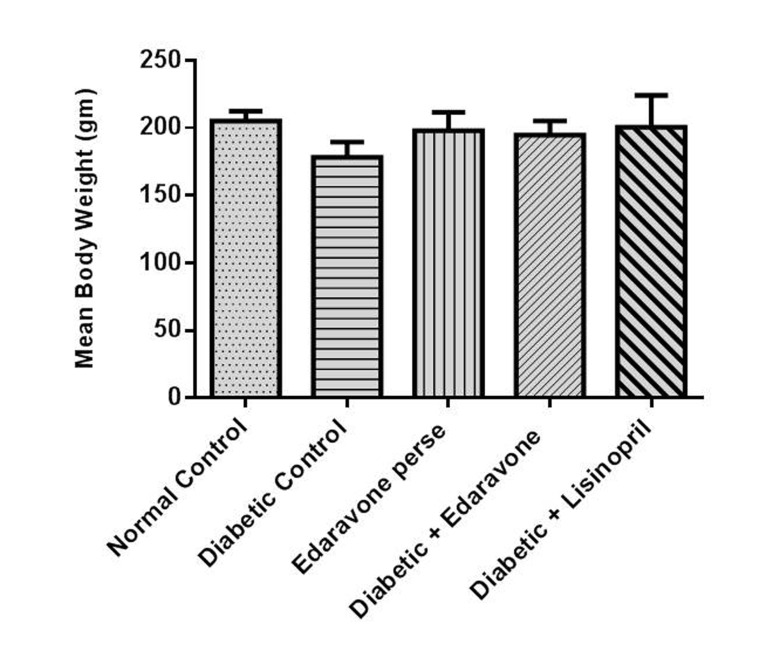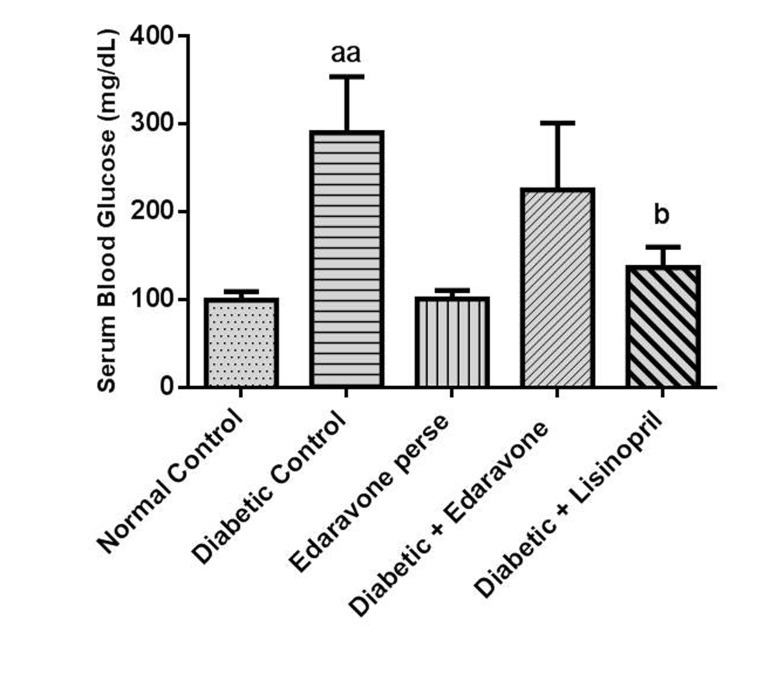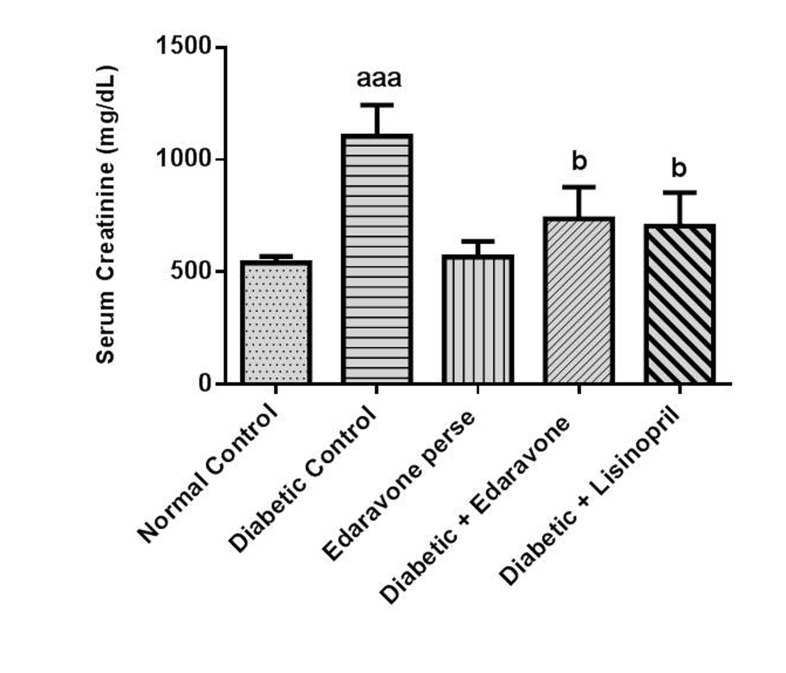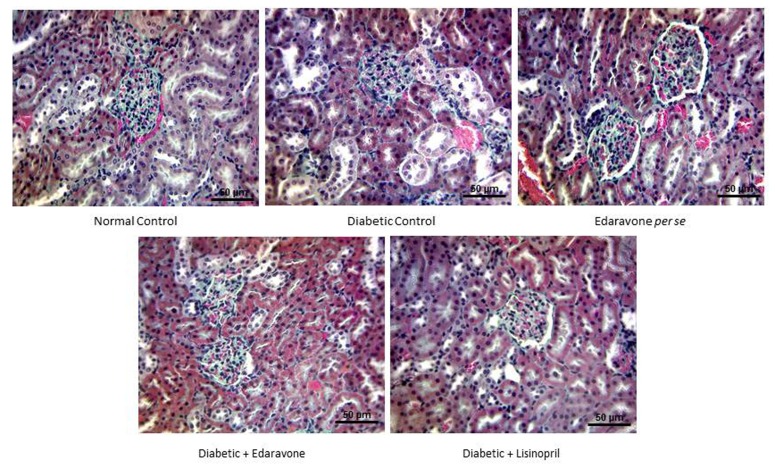Korean J Physiol Pharmacol.
2016 Jul;20(4):333-340. 10.4196/kjpp.2016.20.4.333.
Effect of edaravone in diabetes mellitus-induced nephropathy in rats
- Affiliations
-
- 1Pharmacology Unit, Faculty of Pharmacy, AIMST University, Semeling, 08100 Bedong, Kedah Darul Aman, Malaysia. varadharajeen@gmail.com
- 2Department of Pharmacology, Faculty of Medicine, University of Malaya, 50603 Kuala Lumpur, Malaysia.
- 3Pathology Unit, Faculty of Medicine, AIMST University, Semeling, 08100 Bedong, Kedah Darul Aman, Malaysia.
- 4Pharmaceutical Technology Unit, Faculty of Pharmacy, AIMST University, Semeling, 08100 Bedong, Kedah Darul Aman, Malaysia.
- KMID: 2371050
- DOI: http://doi.org/10.4196/kjpp.2016.20.4.333
Abstract
- Edaravone, a synthetic-free radical scavenger, has been reported to reduce ischemia-reperfusion-induced renal injury by improving tubular cell function, and lowering serum creatinine and renal vascular resistance. The present study investigated the effect of edaravone in diabetes mellitus-induced nephropathy in rats. A single administration of streptozotocin (STZ, 55 mg/kg, i.p.) was employed to induce diabetes mellitus in rats. The STZ-administered diabetic rats were allowed for 10 weeks to develop nephropathy. Mean body weight, lipid alteration, renal functional and histopathology were analysed. Diabetic rats developed nephropathy as evidenced by a significant increase in serum creatinine and urea, and marked renal histopathological abnormalities like glomerulosclerosis and tubular cell degeneration. The kidney weight to body weight ratio was increased. Moreover, diabetic rats showed lipid alteration as evidenced by a signifi cant increase in serum triglycerides and decrease in serum high-density lipoproteins. Edaravone (10 mg/kg, i.p., last 4-weeks) treatment markedly prevented the development of nephropathy in diabetic rats by reducing serum creatinine and urea and preventing renal structural abnormalities. In addition, its treatment, without significantly altering the elevated glucose level in diabetic rats, prevented diabetes mellitus-induced lipid alteration by reducing serum triglycerides and increasing serum high-density lipoproteins. Interestingly, the renoprotective effect of edaravone was comparable to that of lisinopril (5 mg/kg, p.o, 4 weeks, standard drug). Edaravone prevented renal structural and functional abnormalities and lipid alteration associated with experimental diabetes mellitus. Edaravone has a potential to prevent nephropathy without showing an anti-diabetic action, implicating its direct renoprotection in diabetic rats.
MeSH Terms
Figure
Reference
-
1. Jahansouz C, Kumer SC, Ellenbogen M, Brayman KL. Evolution of β-cell replacement therapy in diabetes mellitus: pancreas transplantation. Diabetes Technol Ther. 2011; 13:395–418. PMID: 21299398.2. Roshan B, Stanton RC. A story of microalbuminuria and diabetic nephropathy. J Nephropathol. 2013; 2:234–240. PMID: 24475455.3. Tsutsui H, Ojima T, Ozaki N, Kusunoki M, Ishiguro T, Oshida Y. Validation of the comprehensive international classification of functioning, disability and health (ICF) core set for diabetes mellitus in patients with diabetic nephropathy. Clin Exp Nephrol. 2015; 19:254–263. PMID: 24840398.
Article4. Duran-Salgado MB, Rubio-Guerra AF. Diabetic nephropathy and inflammation. World J Diabetes. 2014; 5:393–398. PMID: 24936261.
Article5. Gitter J, Langefeld CD, Rich SS, Pedley CF, Bowden DW, Freedman BI. Prevalence of nephropathy in black patients with type 2 diabetes mellitus. Am J Nephrol. 2002; 22:35–41. PMID: 11919401.
Article6. Singh J, Budhiraja S, Lal H, Arora BR. Renoprotection by telmisartan versus benazepril in streptozotocin induced diabetic nephropathy. Iranian J Pharmacol Ther. 2006; 5:135–139.7. Kadian S, Mahadevan N, Balakumar P. Differential effects of low-dose fenofibrate treatment in diabetic rats with early onset nephropathy and established nephropathy. Eur J Pharmacol. 2013; 698:388–396. PMID: 23085026.
Article8. Rajavel V, Abdul Sattar MZ, Abdulla MA, Kassim NM, Abdullah NA. Chronic administration of oil palm (Elaeis guineensis) leaves extract attenuates hyperglycaemic-induced oxidative stress and improves renal histopathology and function in experimental diabetes. Evid Based Complement Alternat Med. 2012; 2012:195367. PMID: 23243433.
Article9. Varatharajan R, Sattar MZ, Chung I, Abdulla MA, Kassim NM, Abdullah NA. Antioxidant and pro-oxidant effects of oil palm (Elaeis guineensis) leaves extract in experimental diabetic nephropathy: a duration-dependent outcome. BMC Complement Altern Med. 2013; 13:242. PMID: 24074026.
Article10. Singh VP, Bali A, Singh N, Jaggi AS. Advanced glycation end products and diabetic complications. Korean J Physiol Pharmacol. 2014; 18:1–14. PMID: 24634591.
Article11. Kuwabara T, Mori K, Mukoyama M, Kasahara M, Yokoi H, Saito Y, Ogawa Y, Imamaki H, Kawanishi T, Ishii A, Koga K, Mori KP, Kato Y, Sugawara A, Nakao K. Exacerbation of diabetic nephropathy by hyperlipidaemia is mediated by Toll-like receptor 4 in mice. Diabetologia. 2012; 55:2256–2266. PMID: 22610400.
Article12. McKay GJ, Savage DA, Patterson CC, Lewis G, McKnight AJ, Maxwell AP. Warren 3/UK GoKinD Study Group. Association analysis of dyslipidemia-related genes in diabetic nephropathy. PLoS One. 2013; 8:e58472. PMID: 23555584.
Article13. Chen SC, Tseng CH. Dyslipidemia, kidney disease, and cardiovascular disease in diabetic patients. Rev Diabet Stud. 2013; 10:88–100. PMID: 24380085.
Article14. Kikuchi K, Takeshige N, Miura N, Morimoto Y, Ito T, Tancharoen S, Miyata K, Kikuchi C, Iida N, Uchikado H, Miyagi N, Shiomi N, Kuramoto T, Maruyama I, Morioka M, Kawahara KI. Beyond free radical scavenging: Beneficial effects of edaravone (Radicut) in various diseases (Review). Exp Ther Med. 2012; 3:3–8. PMID: 22969835.
Article15. Kikuchi K, Tancharoen S, Takeshige N, Yoshitomi M, Morioka M, Murai Y, Tanaka E. The efficacy of edaravone (radicut), a free radical scavenger, for cardiovascular disease. Int J Mol Sci. 2013; 14:13909–13930. PMID: 23880849.
Article16. Tsujita K, Shimomura H, Kaikita K, Kawano H, Hokamaki J, Nagayoshi Y, Yamashita T, Fukuda M, Nakamura Y, Sakamoto T, Yoshimura M, Ogawa H. Long-term efficacy of edaravone in patients with acute myocardial infarction. Circ J. 2006; 70:832–837. PMID: 16799234.
Article17. Zhang YM, Wang Y, Liu XH, Zhang DW. Cardioprotective effect of edaravone pharmacological postconditioning on acute myocardial ischemia/reperfusion injury: experiment with rats. Zhonghua Yi Xue Za Zhi. 2008; 88:2558–2561. PMID: 19080651.18. Onogi H, Minatoguchi S, Chen XH, Bao N, Kobayashi H, Misao Y, Yasuda S, Yamaki T, Maruyama R, Uno Y, Arai M, Takemura G, Fujiwara H. Edaravone reduces myocardial infarct size and improves cardiac function and remodelling in rabbits. Clin Exp Pharmacol Physiol. 2006; 33:1035–1041. PMID: 17042911.
Article19. Tahara M, Nakayama M, Jin MB, Fujita M, Suzuki T, Taniguchi M, Shimamura T, Furukawa H, Todo S. A radical scavenger, edaravone, protects canine kidneys from ischemia- reperfusion injury after 72 hours of cold preservation and autotransplantation. Transplantation. 2005; 80:213–221. PMID: 16041266.20. Chan JL, Abrahamson MJ. Pharmacological management of type 2 diabetes mellitus: rationale for rational use of insulin. Mayo Clin Proc. 2003; 78:459–467. PMID: 12683698.
Article21. Balakumar P, Arora MK, Ganti SS, Reddy J, Singh M. Recent advances in pharmacotherapy for diabetic nephropathy: current perspectives and future directions. Pharmacol Res. 2009; 60:24–32. PMID: 19427582.
Article22. Rutledge JC, Ng KF, Aung HH, Wilson DW. Role of triglyceride-rich lipoproteins in diabetic nephropathy. Nat Rev Nephrol. 2010; 6:361–370. PMID: 20440276.
Article23. Balakumar P, Kadian S, Mahadevan N. Are PPAR alpha agonists a rational therapeutic strategy for preventing abnormalities of the diabetic kidney? Pharmacol Res. 2012; 65:430–436. PMID: 22285932.
Article24. Doi K, Suzuki Y, Nakao A, Fujita T, Noiri E. Radical scavenger edaravone developed for clinical use ameliorates ischemia/reperfusion injury in rat kidney. Kidney Int. 2004; 65:1714–1723. PMID: 15086910.
Article25. Szkudelski T. The mechanism of alloxan and streptozotocin action in B cells of the rat pancreas. Physiol Res. 2001; 50:537–546. PMID: 11829314.26. Toyama T, Shimizu M, Furuichi K, Kaneko S, Wada T. Treatment and impact of dyslipidemia in diabetic nephropathy. Clin Exp Nephrol. 2014; 18:201–205. PMID: 24198049.
Article27. Balakumar P, Varatharajan R, Nyo YH, Renushia R, Raaginey D, Oh AN, Akhtar SS, Rupeshkumar M, Sundram K, Dhanaraj SA. Fenofibrate and dipyridamole treatments in low-doses either alone or in combination blunted the development of nephropathy in diabetic rats. Pharmacol Res. 2014; 90:36–47. PMID: 25263930.
Article
- Full Text Links
- Actions
-
Cited
- CITED
-
- Close
- Share
- Similar articles
-
- The Anti-inflammatory Effect of Retinoid on Streptozotocin-induced Diabetic Nephropathy
- Effect of Empagliflozin, a Selective Sodium-Glucose Cotransporter 2 Inhibitor, on Kidney and Peripheral Nerves in Streptozotocin-Induced Diabetic Rats
- Glycemic Control in Diabetic Patients with Diabetic Nephropathy
- Effects of Diabetes Mellitus on the Disposition of Tofacitinib, a Janus Kinase Inhibitor, in Rats
- Effect of Melatonin on the Diabetes Mellitus Induced by Streptozotocin in Rats











